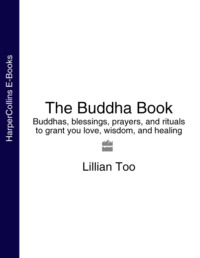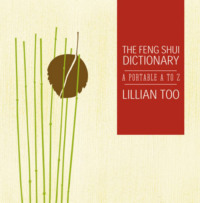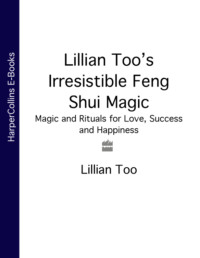
Полная версия
Lillian Too’s Flying Star Feng Shui For The Master Practitioner
Each Kua of the eight-sided Pa Kua symbol represents one major direction of the compass. And on each side is arranged the eight primary trigrams. These trigrams are placed in different arrangements thereby creating the Pa Kua of the Early Heaven arrangement and the Pa Kua of the Later Heaven arrangement. Both these arrangements appear in all Luo Pans. At the same time, the Lo Shu and Ho Tu squares were discovered and the numbers of these two numerology sequences were also synthesized into the Pa Kua and into the Luo Pan.
As a feng shui tool, the Luo Pan has been in use since the time of the Yellow Emperor around 2700 BC. It was initially used as a compass for taking directions before being refined into a complicated instrument for analyzing the landscape. Basically the Luo Pan was used to decipher the directional forces of nature and their bearing on the luck of abodes and their residents. Through the centuries and under different dynasties of imperial rule, the practice of feng shui has waxed and waned, but the Luo Pan evolved to contain the different formulas developed by different prominent masters during succeeding dynastic rules. Feng shui masters through the ages condensed their valuable observations and discoveries into working formulas, and their precious knowledge was engraved into the Luo Pan, to be passed down to their disciples.
During the Sung dynasty the lineage of transmission of divinatory sciences from one recognized master to the next was carefully chronicled. These transmissions included feng shui. In those times recognized experts were highly esteemed and feng shui practice flourished. The next dynasty significant to the story of feng shui was that of the Ming dynasty. During this time, feng shui developed new styles and orientations – rules were simplified and mountains, rivers, and stones were reclassified. Time cycles of feng shui were said to have been “invented” at this time, with the introduction of the Sarn Yuan (three periods or three cycles) system. Each cycle lasted 60 years, made up of three cycles of 20 years. This was to eventually become the basis of the Flying Star system of feng shui, which is gaining increasing popularity today, perpetuated by masters of the Compass schools. Flying Star formulas found their way into the feng shui Luo Pan which, during the Ming period, also expanded from 17 to 36 rings. In the late Ming, however, feng shui took on a bad name as “fake” masters and books were said to have become rather widespread.
For this reason later feng shui scholars were extremely critical of Ming-period feng shui. During the Ching period, the practices expounded by the Ming scholars were censured and as a result there was movement towards embracing the more theoretical texts of the Sung practitioners.
2. THE FENG SHUI LUO PAN TODAY
Today the Luo Pan and its rings of symbols, trigrams, numbers, and Chinese words is regarded as an indispensable instrument by professional feng shui consultants. In the same way that the abacus continues to be used by Chinese merchants who prefer it to the modern-day calculator, feng shui practitioners of the old school prefer using the Luo Pan to the modern-day compass.
Of the many different feng shui techniques requiring the use of the compass the most popular and influential are:
The time cycle techniques also known as Time Dimension feng shui. This incorporates the Flying Star, or Shuan Kong, method of feng shui analysis.
The Three Harmony method which refers to the harmony between Heaven, Earth, and Man, as reflected in the Heaven Plate, the Earth Plate, and the Man Plate of the Luo Pan. This Luo Pan is very comprehensive and contains three sets of rings, each denoting one of the plates. This is a combination Luo Pan which has many Chinese words and is said to be the most complete as it also contains information on time cycle feng shui.
The feng shui Luo Pan is first and foremost a compass for measuring directions. So the most important part of the Luo Pan is the magnetic needle and directional marking in the center. It is vital never to compromise on the quality of this central needle since so many of the nuances of good and bad luck depend on accurate compass readings.
To reiterate: the Luo Pan divides directions into 360 degrees around a point of reference. This is divided into eight main directions and 24 sub-directions. These sub-directions are referred to as the 24 mountains, and each mountain measures 15 degrees (360 divided by 24 equals 15). The rings that indicate the 24 mountains of the different plates are very important simply because many of the major feng shui formulas use the 24 mountains to express and demarcate good and bad luck orientations. So all Luo Pans have the 24 mountains.
The remaining rings, however, can contain a number of different formulas, as Luo Pans vary according to which master designed them. Even when they contain the same formulas they may be presented in a different way. The numbers and characters of the Luo Pan are therefore confusing to the uninitiated – until they are interpreted and explained.
I want to stress that you do not need to invest in a Luo Pan to become an excellent feng shui practitioner. It is important only to know how to use a compass and how to measure, use, and apply directions according to the formulas. So as long as you have a compass – any good compass – you can apply all the secrets of the Luo Pan.
If, however, you do wish to invest in a Luo Pan here are a few guidelines. Good Luo Pans are made with precision and care, and are best crafted from wood – they should never be made of plastic, cardboard, or paper. The face of the compass, i.e. where the rings are placed, is known as the heaven dial and this sits on a base made of wood known as the earth plate. The heaven dial or face of the Luo Pan is usually made of stamped copper plate. High-quality Luo Pans have clear, sharp, and well-crafted characters and measurement degrees, and they never rust. Examine it carefully to make certain it is made of good materials and that the compass in the center is accurate and of good quality. Choose a size you feel comfortable with. A medium-sized Luo Pan is usually sufficient to contain all the essential information. When you buy a Luo Pan you should take care of it, storing it properly, and keeping it away from electrical and metallic devices so the needle stays sound.
Here are further pointers to take note of when examining a Luo Pan …
1 Take special note of the needle quality. This is the most vital part of the compass, and is the single most expensive part of any Luo Pan. The needle must align accurately on top of the red line in the center of the compass. Never buy a Luo Pan with a cheap needle. Also remember that the needle is extremely sensitive to metallic objects so a large needle might be better than a small one.
2 The two red dots must be present and these should point north (the rat direction) while the point of the needle should point south (the horse direction).
3 Look at the accuracy of the axis cross. These are the two nylon threads that must cross the cardinal axis directly at 0, 90, 180, and 270 degrees of the heaven dial. There cannot be even the slightest deviation. If there is, the Luo Pan is deemed to be worthless.
4 Take note of the heaven dial, which must be clear and not blurred so that characters can be read easily.
5 Turn the Luo Pan on its earth base – it should move freely and feel smooth.
6 The earth base should be square as directions are often taken by pressing it parallel to the wall or door of a building – the four sides must thus be square and straight.
Generally I would say that for beginners, and for those who want to practice Yang feng shui, the ring of the 24 mountains is the most crucial – and this can easily be committed to memory using an ordinary compass.
3. SPECIAL LINES OF THE LUO PAN
Before we go into the details of the concentric lines around a Luo Pan, it is extremely important to take note of the special lines that indicate inauspicious directions. These pertain to what are known as the cardinal death lines and the major and minor emptiness lines. (The phrase death lines do not necessarily mean death in a physical sense. It can also refer to loss, failure, and other extreme forms of bad luck.) One of the most well-kept secrets of Compass feng shui – previously known only to lineage masters – is that the facing directions of doors and entrances should never lie exactly on the lines that indicate the exact cardinal and secondary directions of the compass. On a Luo Pan these lines are easily identifiable – they are the lines that bear exactly north, south, east, and west, and northwest, southwest, northeast, and southeast. Thus if north is deemed to be the best direction for you and you wish to have your door face north, then you should make sure it does not face exactly north but rather a couple of degrees off exact north. This is true of all the four primary directions and the four secondary directions.
Kung mang, or emptiness lines, also spell misfortune and severe bad luck. There are eight major emptiness lines and these separate each of the eight main direction sectors – N, S, E, W, NW, NE, SW, and SE. There are also16 minor emptiness lines and these separate the 24 mountain sub-sectors in each of the eight sectors.
The inauspicious and dangerous lines of directions are as follows:
The death lines are the cardinal directions bearing 90, 180, 270 and 0/360 degrees, as well as the secondary directions bearing 45, 135, 225, and 315 degrees.
The major emptiness lines are directions that are bearing 22.5, 67.5, 112.5, 157.5, 202.5, 247.5, 292.5, and 337.5 degrees.
The minor emptiness lines are directions that are bearing 7.5, 11.25, 33.75, 37.5, 52.5, 56.25, 78.75, 82.5, 97.5, 101.25, 123.75, 127.5, 142.5, 146.25, 168.75, 172.5, 187.5, 191.25, 213.75, 217.5, 232.5, 236.25, 258.75, 262.5, 277.5, 281.25, 303.75, 307.5, 322.5, 326.25, 348.75 and 352.5 degrees.
If you discover that your house is facing a death line or a major or minor emptiness line, and you are unable to change the orientation of your door, one method of at least reducing the negative effect is to place some kind of metal decoration on the door itself. This can be a door knocker (the best are brass lion head door knockers) or you can also hang sword coins on the inside of the door. The introduction of a bit of metal is usually sufficient to move the chi so that the main door into the house no longer faces the death or emptiness line. Having said this, please note that if you are having a spate of enormous bad luck and you discover that your door is facing one of these lines then it might be a good idea to adjust the door slightly so that it no longer faces the dangerous line of direction.
Another little-known method is to transform your house into a “heavenly abode” by placing an altar directly opposite the entrance door. You will find that the Chinese like to place their altars here and it is said to be an excellent antidote for overcoming the affliction caused by facing a kung mang, or emptiness line. It is believed not only to deflect the ill-effects of emptiness lines but also to bring in auspicious luck instead. Irrespective of your religion it is said that once you introduce an altar, any kind of altar, the emptiness line gets broken.
In addition to death and emptiness lines, there are also certain directions that are referred to as Yin gaps, and these indicate problems in human relations for the residents. Doors that face Yin gaps cause problems between spouses and create family disharmony, marriage problems, and can even lead to eventual breakups. The Yin gaps are the direct centerlines of each of the 24 sub-direction sectors.
These deadly directions and Yin gaps bring secret afflictions to any building and, because of this, feng shui masters who know about Compass feng shui always check this aspect of any home or office before they do anything else. When advising on the design of new homes this is also taken into account. Usually compass directions are taken during the actual construction of any home to ensure that directions are properly read and applied.
Since the compass is affected by the presence of metal, it is important to remember that main doors are best when they are made of wood. If there is metal on the door this should be taken into account when checking the door direction during construction.
Конец ознакомительного фрагмента.
Текст предоставлен ООО «ЛитРес».
Прочитайте эту книгу целиком, купив полную легальную версию на ЛитРес.
Безопасно оплатить книгу можно банковской картой Visa, MasterCard, Maestro, со счета мобильного телефона, с платежного терминала, в салоне МТС или Связной, через PayPal, WebMoney, Яндекс.Деньги, QIWI Кошелек, бонусными картами или другим удобным Вам способом.






